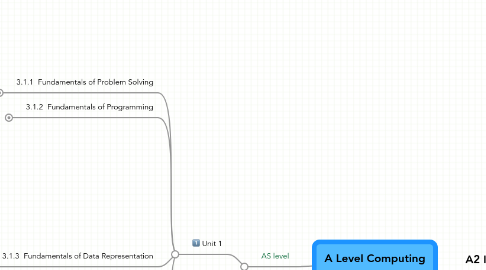
1. AS level
1.1. Unit 1
1.1.1. 3.1.1 Fundamentals of Problem Solving
1.1.1.1. Introduction to Principles of Computation
1.1.1.2. Stages of Problem Solving
1.1.1.3. Top-down Design / Step-wise Refinement
1.1.1.4. Decision tables
1.1.1.5. Finite state machines with outputs
1.1.1.6. Algorithm Design
1.1.2. 3.1.2 Fundamentals of Programming
1.1.2.1. Features of Imperative High Level Languages
1.1.2.2. Data Types
1.1.2.3. The Role of Variables
1.1.2.4. Programming Statements
1.1.2.5. Built-in functions
1.1.2.6. Operators
1.1.2.6.1. Arithmetic operators
1.1.2.6.2. Boolean operators
1.1.2.6.3. Relational operators
1.1.2.6.4. Logical bitwise operators
1.1.2.6.5. Set operators
1.1.2.7. Procedure and Function Parameters
1.1.2.8. Fundamentals of Structured Programming
1.1.2.9. Data Structures
1.1.2.10. Validation
1.1.3. 3.1.3 Fundamentals of Data Representation
1.1.3.1. Bit Patterns in a Computer
1.1.3.2. Pure Binary Representation of Denary Integers
1.1.3.3. Binary Arithmetic
1.1.3.4. Representation of signed integers by Two’s Complement
1.1.3.5. The Concept of Number Bases: Denary, Binary and Hexadecimal
1.1.3.6. Integers and Numbers with a Fractional Part
1.1.3.7. Information Coding Schemes (Text)
1.1.3.8. Error checking and correction
1.1.3.9. Gray coding
1.1.3.10. Representing sound
1.1.3.11. Representing graphics
1.1.4. 3.1.4 Systems Development Life Cycle
1.1.4.1. Analysis
1.1.4.2. Design
1.1.4.3. Implementation
1.1.4.4. Testing
1.1.4.5. Evaluation
1.2. Unit 2
1.2.1. 3.2.1 Fundamentals of Computer Systems
1.2.1.1. Hardware and Software
1.2.1.2. Classification of Software
1.2.1.3. System Software
1.2.1.4. Application Software
1.2.1.5. Generations of Programming Language
1.2.1.6. Types of Program Translator
1.2.2. 3.2.2 Fundamental Hardware Elements of Computers
1.2.2.1. Logic Gates
1.2.2.2. Boolean Algebra
1.2.3. 3.2.3 Machine Level Architecture
1.2.3.1. Internal and External Hardware Components of a Computer
1.2.3.2. Functional Characteristics of a Processor
1.2.3.3. Structure and Role of the Processor
1.2.3.4. Machine code and processor instruction set
1.2.3.5. The Fetch–Execute cycle and the role of registers within it
1.2.4. 3.2.4 Hardware Devices
1.2.4.1. Input and Output Devices
1.2.4.2. Secondary Storage Devices
1.2.5. 3.2.5 The Structure of the Internet
1.2.5.1. The Internet and its Uses World Wide Web (WWW) Intranet
1.2.5.2. Uniform Resource Locator (URL) Uniform Resource Identifier (URI)
1.2.5.3. Domain Names and IP Addresses
1.2.5.4. Internet registries and Internet registrars
1.2.5.5. Internet Service Providers (ISP)
1.2.5.6. Domain Name Server (DNS)
1.2.5.7. The Client–Server Model
1.2.5.8. Common Standard Protocols:
1.2.6. 3.2.6 Web page design
1.2.6.1. Web page construction
1.2.6.2. HTML & style sheets
1.2.7. 3.2.7 Consequences of Uses of Computing
1.2.7.1. Legal and Ethical Issues
1.2.7.2. Economic and Social Issues
2. A2 level
2.1. Unit 3
2.1.1. 3.3.1 Problem Solving
2.1.2. 3.3.2 Programming Concepts
2.1.3. 3.3.3 Real Numbers
2.1.4. 3.3.4 Operating Systems
2.1.5. 3.3.5 Databases
2.1.6. 3.3.6 Communication and Networking
2.2. Unit 4
2.2.1. The Computing Practical Project
